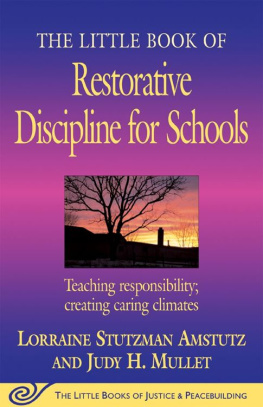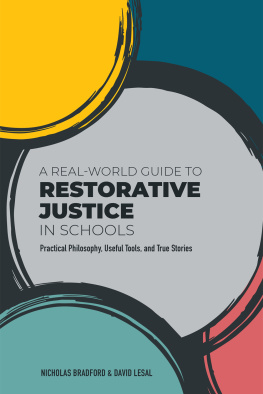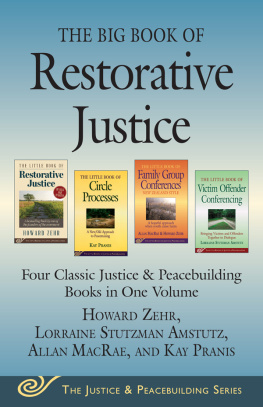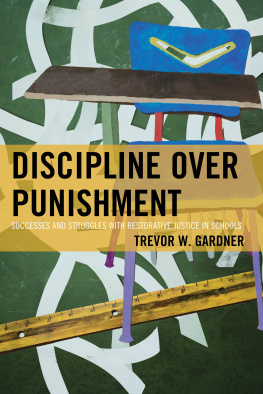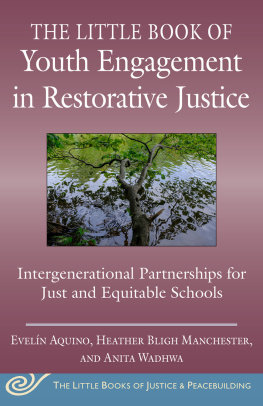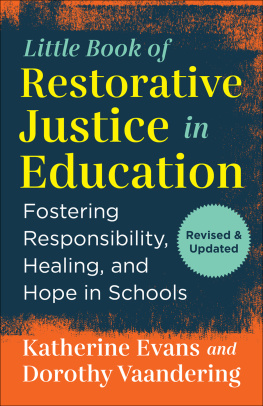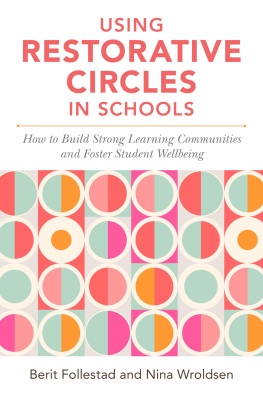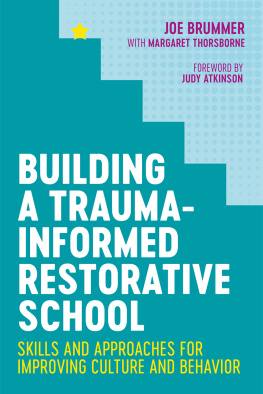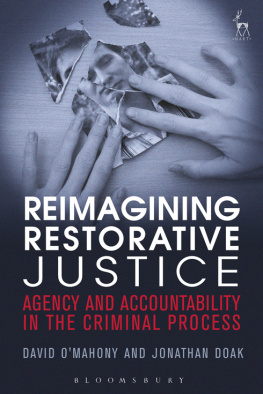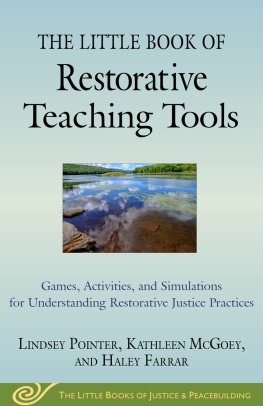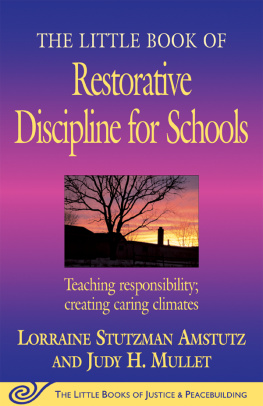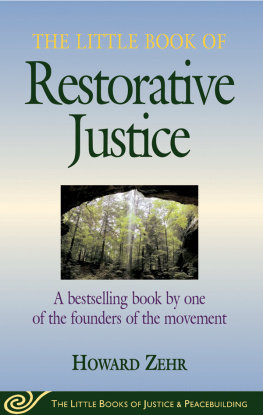
Published titles include:
The Little Book of Restorative Justice, by Howard Zehr
The Little Book of Conflict Transformation, by John Paul Lederach
The Little Book of Family Group Conferences, New-Zealand Style, by Allan MacRae and Howard Zehr
The Little Book of Strategic Peacebuilding, by Lisa Schirch
The Little Book of Strategic Negotiation, by Jayne Seminare Docherty
The Little Book of Circle Processes, by Kay Pranis
The Little Book of Contemplative Photography, by Howard Zehr
The Little Book of Restorative Discipline for Schools, by Lorraine Stutzman Amstutz and Judy H. Mullet
The Little Book of Trauma Healing, by Carolyn Yoder
The Little Book of Biblical Justice, by Chris Marshall
The Little Book of Restorative Justice for People in Prison, by Barb Toews
El Pequeo Libro De Justicia Restaurativa, by Howard Zehr
Forthcoming titles or topics include:
The Little Book of Cool Tools for Hot Topics, by Ron Kraybill and Evelyn Wright
The Little Book of Dialogue, by Lisa Schirch and David Campt
The Little Book of Victim Offender Conferencing, by Lorraine Stutzman Amstutz
The Little Books of Justice & Peacebuilding present, in highly accessible form, key concepts and practices from the fields of restorative justice, conflict transformation, and peacebuilding. Written by leaders in these fields, they are designed for practitioners, students, and anyone interested in justice, peace, and conflict resolution.
The Little Books of Justice & Peacebuilding series is a cooperative effort between the Center for Justice and Peacebuilding of Eastern Mennonite University (Howard Zehr, Series General Editor) and publisher Good Books (Phyllis Pellman Good, Senior Editor).
Acknowledgments
From Lorraine: A special heartfelt thanks to my spouse, Jim, who continually encourages me to be all that I can be and supports me on that journey. Thanks also to my children, Solomon, Jordan, and Leah, who courageously allow me to practice what I preach.
From Judy: To my mother who taught me to be an artist for peace no matter what my occupation. To my father who taught me not to criticize an idea unless I had a more life-giving thought to offer. To my children and spouse who bring me tenderness.
Both of us would like to thank those who provided inspiration, suggestions, and critical review of this Little Book, with special thanks to Howard Zehr for his constant encouragement.
Copyright 2014 by Lorraine Stutzman Amstutz and Judy H. Mullet
All rights reserved. No part of this book may be reproduced in any manner without the express written consent of the publisher, except in the case of brief excerpts in critical reviews or articles. All inquiries should be addressed to Good Books, 307 West 36th Street, 11th Floor, New York, NY 10018.
Good Books books may be purchased in bulk at special discounts for sales promotion, corporate gifts, fund-raising, or educational purposes. Special editions can also be created to specifications. For details, contact the Special Sales Department, Good Books, 307 West 36th Street, 11th Floor, New York, NY 10018 or info@skyhorsepublishing.com.
Good Books in an imprint of Skyhorse Publishing, Inc., a Delaware corporation.
Visit our website at www.goodbooks.com.
10 9 8 7 6 5 4 3 2 1
Library of Congress Cataloging-in-Publication Data is available on file.
Cover photograph by Howard Zehr.
Design by Dawn J. Ranck
Print ISBN: 978-1-56148-506-2
Ebook ISBN: 978-1-68099-043-0
Printed in the United States of America
Library of Congress Cataloging-in-Publication Data
Amstutz, Lorraine Stutzman.
The little book of restorative discipline for schools : teaching responsibility, creating caring climates / Lorraine Stutzman Amstutz and Judy H. Mullet.
p. cm.
Includes bibliographical references.
ISBN 1-56148-506-3; 978-1-56148-506-2 (pbk.)
1. School discipline. 2. Conflict management. 3. Restorative justice. 4. Teacherstudent relationships. I. Mullet, Judy H. II. Title.
LB3012.A52 2005
Table of Contents
Introduction
The secret of education lies in respecting the pupil.
Ralph Waldo Emerson
S ituations requiring discipline in our schools can, in fact, be opportunities for learning, growth, and community-building. This idea is based on the assumption put forth by Nel Noddings, author of Caring: A Feminine Approach to Ethics and Moral Education, that the aim of education is to reveal an attainable image of self that is lovelier than that manifested in his or her present acts.
For this to happen, we will need to move beyond viewing discipline as punishment, or even as problem-solving, to a more holistic perspective that sees all aspects of behavior as related. A number of developments in education and related fields are already pointing in this direction. We will especially draw upon two of these.
First, the peaceable school concept acknowledges that education is for and by the community. This concept has been widely recognized and written about within education and has significant implications for our subject. Second, the principles and values of restorative justice have much to say about the way we live in community with one another, including in our schools. Although in our Western culture, restorative justice emerged initially within the criminal justice field, this approach is increasingly gaining recognition and application in the educational arena.
This book draws upon these and other concepts and provides some suggestions about how a restorative approach might be applied to discipline and problem-solving in schools. However, we dont propose a cookie-cutter approach to restorative discipline; to imply such would oversimplify complex and diverse community situations. Rather, a restorative approach is a philosophy or framework that can guide us as we design programs and make decisions within our particular settings.
Restorative discipline is a philosophy or framework.
We urge you to think about the values and principles of restorative justice and to adapt them to fit your situation. We believe that doing so honors the strength and competencies within your own setting.
We offer this Little Book as a resource for teachers and administrators. We hope it can be a helpful addition to the knowledge and expertise already available to you within your school.
We begin by telling two stories that for some may sound too good to be true, too pie-in-the-sky. We tell these stories, however, to show the potential we believe a restorative approach has for our schools, recognizing that much of what we talk about is like planting seeds.
We have no illusions that implementing restorative approaches is the cure for all behavior issues. We also have stories of frustration, of working with students in situations where it seemed uncertain whether the seeds would take root. But the following two stories demonstrate that encouraging empathy can foster compassion and motivate right choices. When we ask our children to put themselves in others shoes, possibilities can become reality.
Someone once noted that there are at least 500 choices in every conflict situation. Options not yet considered exist daily in our classrooms. To discover these options requires creative thinking and a sense of possibility. We believe this vision of untried possibilities is the new but often neglected frontier in community education. We hope these stories will help foster this vision in your educational setting.

